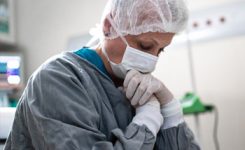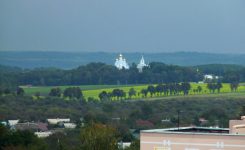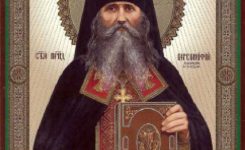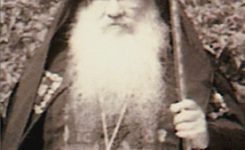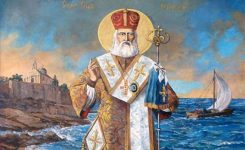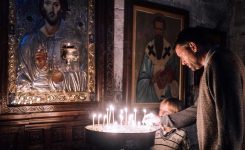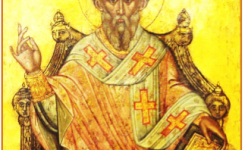monastery musings
Saint Spyridon Notes
Saint Spyridon notes from Gerontissa Theonymphe on Corfu
Hello to all of you, those who attend the blessed Queen of All Skete, and to those who follow the Site prepared by the Skete. Special greetings to the hard-working Mother Superior, Mother Andrea, Evlogeite!
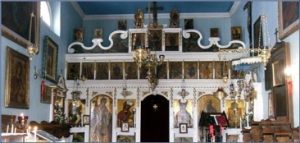
The historic church at Gerontissa Theonymphe’s Panayiopoula metochi, built in the early 1600s in the heart of Corfu’s old town.
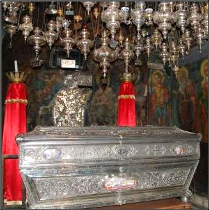
Silver casket of Saint Spyridon
As you know, Corfu is blessed as the honored owner of the Holy relics of Saint Spyridon, a long story going back many years. The relics are preserved in the enormous Church called the Ayio, in the center of town. Throughout the day the clerics open the protective doors and allow people to venerate the Saint’s
holy relics, whole, intact, lying in a massive silver casket, over which hang numerous candilia [vigil lamps]. Nearby is the right arm of the Saint in a separate Holy Relic box having come more recently to the island. All this time the clerics read names submitted, for health, enlightenment, and salvation. The process must be speedy for so many wait in long lines to venerate the relics.
Near to the exit door of this very spacious, magnificent church, where enormous silver candelabras hang, each having been donated by a recipient of Saint Spyridon’s grace, there is a small office. Here you can obtain 1 or 2 φυλαχτα [filakta, amulets], precious, protective snippets from the Holy slippers of the Saint wrapped in a paper square with a distinctive printed icon of the Saint. These filakta must now be in every village of Russia, for pious Russians come, hundreds of them every day, to worship their Saint. The slippers of the Saint, changed each year because they are worn out after his many saving and comforting travels, are fashioned from richly embroidered red velvet, and after the ritual of the old to new, the old are then snipped into small pieces, and given to believers for protection and relief of troubles.
Miracles of the Saint are well known, those mentioned in the Saint’s troparion, and others: saving Corfu from wicked invaders, from the plague, from drought, from famine – major incidents, acknowledged now in four celebrations through the year. Icons showing these God-sent wonders can be seen throughout the island. There is one hanging in the reception room of the Metropolitan’s headquarters. The most common icon is of the Saint wearing his knitted shepherd’s cap which hangs in every house.
from the plague, from drought, from famine – major incidents, acknowledged now in four celebrations through the year. Icons showing these God-sent wonders can be seen throughout the island. There is one hanging in the reception room of the Metropolitan’s headquarters. The most common icon is of the Saint wearing his knitted shepherd’s cap which hangs in every house.
A little-known miracle occurred at the Corfiot Cell of Saint Spyridon on Mount Athos, where the brotherhood was anxiously waiting for fresh fish to cook in time for the guests on the celebratory day of the Saint, Dec 12 [Dec. 25]. The Elder of the Cell refused to worry and continued praying. After tapping at the door, a fisherman entered with his baskets full of fresh fish. “I want to give them to your Elder,” he said, but refused to converse with the Elder now in front of him. “Not you. The other one.” The fisherman went into the church to light his candles and seeing the icon of Saint Spyridon, he cried “Him. He told me to come here and even offered me a down payment.” You see? Yet another of the many wonders worked by this beloved Saint. The first and most graphic miracle is the one that occurred at the First Ecumenical Synod, in 325, which had been convened by the great Emperor-Saint Constantine. Bishops and educated Elders of the Church from all over the realm argued about the Holy Trinity. Saint Spyridon, the uneducated Bishop from Trimythous, Cyprus, stood, took a clay tile in his hand, squeezed it till fiery flames leapt out, water ran down and only a clay lump lay in his hands. Three elements in one. This was really convincing for everyone. At the same time St. Spyridon became annoyed with the loud incomprehensible opinions of a Greek philosopher at the Synod. Relying on his faith, he asked the noisy Greek if he believed the correct theory about the Trinity, and other questions. In this way, he demolished the unfounded claims of the philosopher, who repented and asked to be baptized, whilst his students mocked him for bending to an unschooled Elder. The philosopher told his students: ‘’When I heard this Elder, and saw the Holy Light from his mouth, all my unsound ideas became valueless, and my mind was enlightened by the Elder’s Godly inspired words. So I suggest that you abandon the
The first and most graphic miracle is the one that occurred at the First Ecumenical Synod, in 325, which had been convened by the great Emperor-Saint Constantine. Bishops and educated Elders of the Church from all over the realm argued about the Holy Trinity. Saint Spyridon, the uneducated Bishop from Trimythous, Cyprus, stood, took a clay tile in his hand, squeezed it till fiery flames leapt out, water ran down and only a clay lump lay in his hands. Three elements in one. This was really convincing for everyone. At the same time St. Spyridon became annoyed with the loud incomprehensible opinions of a Greek philosopher at the Synod. Relying on his faith, he asked the noisy Greek if he believed the correct theory about the Trinity, and other questions. In this way, he demolished the unfounded claims of the philosopher, who repented and asked to be baptized, whilst his students mocked him for bending to an unschooled Elder. The philosopher told his students: ‘’When I heard this Elder, and saw the Holy Light from his mouth, all my unsound ideas became valueless, and my mind was enlightened by the Elder’s Godly inspired words. So I suggest that you abandon the
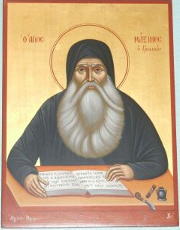
Saint Maximos the Greek icon from Keli Bolioton on Mount Athos. The holy icon is now at Gerontissa Theonymphe’s Skete on Corfu, the Metochi Panayiopoula dedicated to the Virgin Mary Hodigitria.
pointless arguments, do as I do, and together we will follow the Elder.’’ This account you can read in the works of St Maximus the Greek, Jan. 21 [Feb. 3], known as the Enlightener of the Russians.
Apolytikion of Spyridon the Wonderworker
First Tone
Thou wast shown forth as a champion of the First Council
and a wonderworker, O Spyridon, our Godbearing Father.
Wherefore, thou didst speak unto one dead in the grave,
and didst change a serpent to gold.
And while chanting thy holy prayers,
thou hadst angels serving with thee, O most sacred one.
Glory to Him that hath glorified thee!
Glory to Him that hath crowned thee!
Glory to Him that worketh healing for all through thee!
Kontakion of Spyridon the Wonderworker
Second Tone
Wounded with love for Christ, O most sacred one,
Thou didst give wings to thy mind with the radiance of the Spirit,
thou didst find thy work in active Divine vision, O divinely inspired one. Thou
becamest a divine altar, asking for Divine illumination for all.
Megalynarion of Saint Spyridon the Wonderworker
Rejoice, thou mighty river of miracles;
Rejoice, O wise physician
Of the sick and the suffering;
Rejoice, thou godly sower
Who sowed the Spirit’s doctrine;
O Spyridon, rejoice, thou shepherd of Trimython.
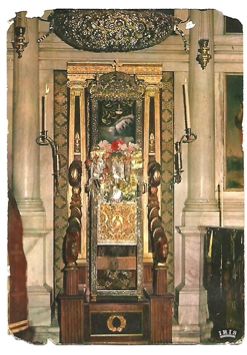
Antique postcard from Corfu, showing the Saint’s casket standing up in the Bishop’s throne of the Church
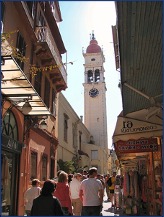
View of the bell tower of Saint Spyridon’s Church on Corfu.

